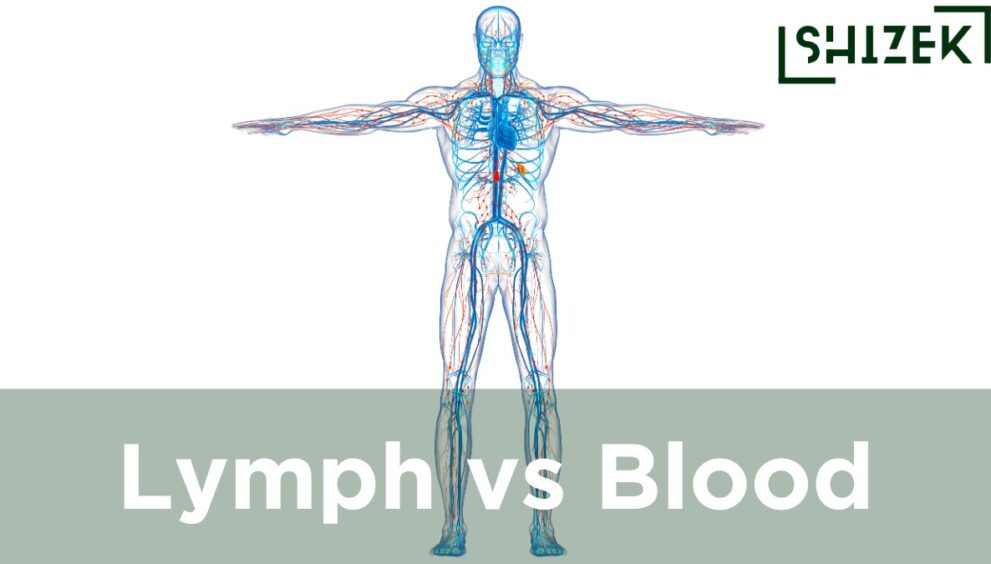Difference Between Lymph and Blood

Our bodies are complex machines that rely on several different systems to function correctly. Two of the most critical fluids in our body are blood and lymph. While they share some similarities, understanding the key differences between these fluids is crucial for understanding how our body works. In this article, we will explore the primary differences between lymph and blood and their roles in maintaining our overall health and well-being. Whether you’re a medical professional or just curious about how your body works, this article will provide you with valuable insights into these essential bodily fluids.
Table of Content
- Difference Between Lymph and Blood: Lymph vs Blood
- What is Lymph?
- What is Blood?
- Key Difference Between Lymph and Blood
Difference Between Lymph and Blood: Lymph vs Blood
| Parameter | Lymph | Blood |
| Components | Mostly contains white blood cells (lymphocytes), with some red blood cells and platelets. | Contains red blood cells, white blood cells, platelets, and plasma. |
| Function | Helps in the immune response by transporting lymphocytes to the site of infection. | Transports oxygen, nutrients, hormones, and waste products to and from cells. |
| Color | Colorless or pale yellow due to the absence of red blood cells. | Red, due to the presence of haemoglobin in red blood cells. |
| Volume | Less than blood, about 2-4 liters in the human body. | Approximately 4-6 liters in the human body. |
| Circulation Path | Circulates through lymphatic vessels and does not have a pump like the heart. | Circulates through the heart and blood vessels. |
| Pressure | Lower pressure, as it is pumped by the movement of muscles rather than by the heart. | Higher pressure, actively pumped by the heart. |
| Transport Medium | Lymph serves primarily as a medium for transporting immune cells and for absorbing fats. | Blood serves as the primary medium for transporting all cells, nutrients, gases, and waste products. |
| Clotting Factors | Contains fewer clotting factors compared to blood. | Contains all the essential clotting factors and is involved in hemostasis. |
| Protein Content | Lower protein content than blood plasma mainly contains albumin. | Higher protein content, including albumin, globulins, fibrinogen, and other clotting factors. |
| Origin | Formed as a filtrate from the blood plasma in the capillaries then enters lymphatic vessels. | Formed in the bone marrow (red blood cells, white blood cells, platelets) and includes plasma. |
What is Lymph?
Lymph is a colorless fluid that circulates throughout the lymphatic system, a network of thin tubes and bean-shaped organs called lymph nodes. The lymphatic system is part of your immune system and plays a crucial role in keeping your body healthy.
Composition of Lymph
Lymph is similar to blood plasma, the liquid part of blood, but it has fewer proteins and red blood cells. Lymph contains:
- Water
- Electrolytes (salts and minerals)
- Proteins
- Lymphocytes (white blood cells)
- Fats (in lacteals)
- Waste products
- Bacteria and viruses
Functions of Lymph
- Drains excess fluid: Lymph helps drain excess fluid that collects between cells (interstitial fluid) back into your bloodstream. This prevents swelling and helps maintain fluid balance in your body.
- Transports immune cells: Lymph carries white blood cells, called lymphocytes, throughout your body. These cells help fight infection and disease.
- Filters waste products: Lymph nodes filter out waste products, bacteria, viruses, and dead cells from the lymph fluid.
- Absorbs fats: Lymph vessels in the small intestine (lacteals) absorb fats and fat-soluble vitamins from digested food and transport them to the bloodstream.
What is Blood?
Blood is a vital fluid that constantly travels throughout your body’s circulatory system, delivering essential supplies to your cells and tissues. It’s kind of like a moving delivery truck keeping everything running smoothly.
Composition of Blood
Blood is a mixture of two main components:
- Plasma (55%): This is the liquid part of your blood, mostly made up of water (around 92%) but also containing proteins, salts, hormones, and glucose (sugar) for energy.
- Blood cells (45%): These are the solid components of blood and come in three main types:
- Red blood cells (RBCs): These are the most abundant cells, carrying oxygen throughout your body using a protein called hemoglobin.
- White blood cells (WBCs): These are important for your immune system, helping fight infection and disease.
- Platelets: These tiny cell fragments help your blood clot to prevent excessive bleeding when you’re injured.
Functions of Blood
Blood has several important functions in your body:
- Transporting oxygen and nutrients: RBCs deliver oxygen from the lungs to the cells and tissues, while plasma carries nutrients like glucose and amino acids to the cells.
- Removing waste products: Blood carries carbon dioxide, a waste product from your cells, back to your lungs for exhalation. It also carries other waste products to your liver and kidneys for removal.
- Fighting infection: WBCs help identify and destroy pathogens (harmful germs) that enter your body.
- Maintaining internal balance: Blood helps regulate body temperature and keeps your body’s pH (acidity) in check.
- Blood clotting: Platelets help form clots to seal wounds and prevent blood loss.
Key Difference Between Lymph and Blood
- Blood contains both liquid and solid components, whereas lymph is a clear fluid that contains only white blood cells, proteins, and fats.
- Blood circulates through the body via the circulatory system of arteries, veins, and capillaries. Lymph, on the other hand, moves through the lymphatic system, which is a network of vessels and tissues that help to filter and remove excess fluids from the body.
- Blood is red due to the presence of hemoglobin in red blood cells, while lymph is colorless and transparent.
- Blood carries oxygen, nutrients, and hormones throughout the body and helps to remove waste products. On the other hand, lymph helps fight infections and remove excess fluids and waste products from the body.
- Blood cells are formed in the bone marrow, while lymphocytes are formed in the lymphoid tissues, including lymph nodes, spleen, thymus, and tonsils.
Conclusion
Lymph and blood are two critical fluids that play vital roles in ensuring that our body stays healthy. Blood circulates oxygen and nutrients throughout the body, while lymph helps to remove waste and fight infections. While they share some similarities, understanding the key differences between lymph and blood is crucial for a better understanding of how our body functions. By knowing more about these two essential fluids, we can take better care of our bodies and maintain our overall health and well-being.
Check Out Our Other Blogs
- Difference Between Disability and Disorder
- Difference Between Population Growth and Population Change
- Difference Between Lymph and Blood
- Difference Between Covaxin and Covishield
- Difference Between Menarche and Menopause
- Difference Between Malaria and Dengue
- Difference Between Oestrus Cycle and Menstrual Cycle
- 1 Egg Nutrition Facts
- 9 Health Benefits of Yoga
- 7 Days Diet Plan to Lose 5 Kg























































































































